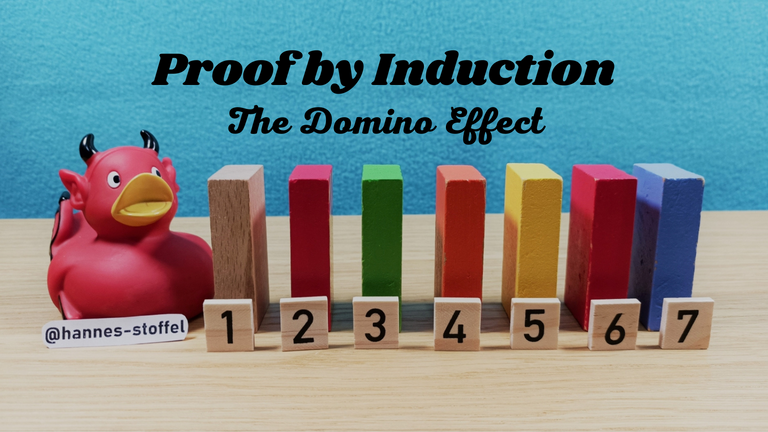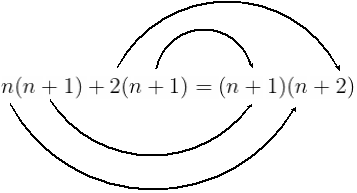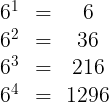Proof by Induction: The Domino Effect

Introduction
Many mathematical proofs are based on deductive reasoning. One fact leads to another and like a detective solving a crime the mathematician takes what is known (so called axioms and premises) and comes to a logical conclusion that proves the theorem.
But every once in a while (and more often than one might think) this kind of thinking is combined with a kind of proof called Mathematical Induction. And the best way to describe it is: The Domino Effect.
Example
Little Gauß at school
You probably heard of the German mathematician Carl Friedrich Gauß (1777-1855). If not, no worries.
When he was nine years old, his math teacher gave the class the task to sum up all (whole) numbers from 1 to 100. Within a few minutes Gauß had the answer as 5050 and was done while all other students where still adding and scribbling. How did he do it?
Gauß realized there was a simple formula to perform this task.
Whenever you need to sum up the numbers from 1 to X you do the following: Multiply X with its successor and divide the result by 2.

But does it really work all the time? Or was it just pure luck?
We could simply plug in a few numbers and see if the formula holds.
Spoiler alert: It does.
For 1 it is simple:

But that could be a coincidence. After all it is just 1 number, we did not really add up anything here, did we?
Let's try 2:

Seems ok. But could be because the 2 is also as a divisor in the formula. Better try 3 as well.

Ok, still holding up. Still pure luck?
If we continue this way we will get a good result all the time. But we can not simply try out all the numbers, there are infinitely many. Who is to say there is not some weird number up there for which the formula breaks?
When Gauß wrote down 5050 as his answer the problem at hand was solved. But could he use that formula every time when such a problem was presented?
This is where proofs come in and in the case of natural numbers, one option is Mathematical Induction.
How it works
Natural Numbers
Natural Numbers are positive whole numbers. The world of mathematics is actually divided by the question "Is zero a natural number?". So some might include zero and some might exclude it. For us it does not matter at this point. We just have to be clear on which side we stand (and this can even change, depending on what we want to prove).
Natural numbers are so important, they got their own symbol in mathematics. You might have seen the weird N before.

The most important fact about natural numbers is: They are lined up in a way so that every number has exactly one successor and we all agree and know what this successor is.
These are our domino pieces.
Tip one over
To tip our first domino piece over, we simply plug in a number, preferably as low as possible, and show that the formula works for that particular number. Remember, we already did that. We plugged in 1, 2 and 3. Does not get lower than one in our case (yes, zero would have worked as well, but what is the point there?).
So here it is again:

Let the others follow
Now comes the inductive part. We prove that if one piece of the domino set falls over (no matter which one), its successor will fall over as well. That is the key to our chain reaction. Because the successor has a successor of its own. And since we proved whenever a piece falls over, its successor will fall as well, this successor will follow. And that will go on and on and on and on ....
How do we do that in a mathematical way? We assume we have a falling piece and have a look at its successor. To make it easier to follow and not confuse the variable in the initial formula with our domino piece and its successor we give them a different name.
The assumed falling piece we call n and therefore its successor would be n+1.
Let us have a look at our formula:

We want to prove that n+1 is falling over. So we plug in n+1 for every X in our formula. That would give us:

This is where we want to end up. But how do we get there?
We have to somehow make use of the fact that we know (assume) piece n is falling over. We know the formula holds for n and want to prove that it also holds for the successor n+1. Our task is to get hold of n and use the knowledge that the formula holds for n. We use that to prove it therefore also holds for n+1.
Let us start on the left side. That n+1 is the successor of n. Therefore we can rewrite the left side also including n as follows:

We know that the formula holds for n so we can plug that in and get an equation:

We took the 1+2+3+...+n and exchanged it for the equation. But there is also (n+1) added at the end. So we had to add that as well.
Using the knowledge that it works for n is essential for the proof. In our domino metaphor it is the fact that one of the pieces is in motion and falling over. What is left to do is to prove that the next piece is now falling as well. In our case, somehow arrive at the target formula for n+1.
For that we need some simple algebra. If we multiply (n+1) with 1 we don't really change anything. Luckily 1 can also be written as 2/2 and that is very useful in this case.

We are adding fractions with the same denominator so we can "pull them together":

This looks promising. We are almost at the target formula but the nominator is not correct yet. Let us have a look at the nominator by itself:

Notice that both terms of our sum have our successor piece (n+1) in them. We can pull that out.

Since 2=1+1 and in addition it does not matter how you put parenthesis we can rewrite (n+2) as ((n+1)+1)

Eureka, we got it. Put that one back in where we pulled it out:

And there we have it. We proved that if the formula holds for one number n, then it also holds for its successor (n+1).
Since we already showed it holds for our first number n=1 it therefore must hold for its successor 2 and the successor that number, namely 3 and so on. Hence this formula is valid for every natural number, no matter how big it is.
Q.E.D.
If you want to show off a little bit, you can put
q.e.d.
at the end of your proof. It is the abbreviation of the latin phrase "quod erat demonstrandum" and means "that, which was to be shown".
Mathematicians put it to signify the end of a proof in bigger articles or to show they are done (or at least think so 😉).
Applications
The proof by Mathematical Induction can be a wonderful tool. Just remember that what you are about to prove has to be in bijective relation to the natural numbers. That means for every natural number there must be a corresponding result in your formula and vice versa.
For example you could prove that
For every natural power (no zero allowed) of 6 the result's last digit is 6
In this case the natural number with its successors is the exponent. Here are the first four examples:

If you are interested in combinatorics, you can use Mathematical Induction for the following:
For X objects there are X! ways to arrange them in a specific order
If you are unfamiliar with the ! sign in mathematics, it is the combined product (aka faculty). That means 3! is 1x2x3=6 and 4!=1x2x3x4=24 and 5!=1x2x3x4x5=120 and so on.
To arrange 3 different objects (let us call them a, b and c) we can arrange them as
- a, b, c
- a, c, b
- b, a, c
- b, c, a
- c, a, b
- c, b, a
Those are the six ways to arrange three different objects.
For both theorems I will post the proof next week, until then have fun getting at them.
Have fun
I hope I could bring this method of proof and understanding it to a few more people. If you understood a little bit of it but not all, feel free to ask in the comments. Alternatively you can also look out for my post next week with the solution to the above mentioned theorems. Maybe that will give you the final "Aha-Moment".
Thank you very much for reading and remember: It's also supposed to be fun!
Header image picture taken by me.
Math pictures created with latex.codecogs.com
This was a lot of text and formulas to create. If I made a blunder somewhere along the line and didn't catch it despite proofreading several times, please let me know in the comments so I can fix it.
Edit: Corrected a typo in the last quote
Edit: Multiplying in text with the asterisk sign was interpreted by the front ends as cursive writing. Changed the multiplication sign to x.
Wow, that was a deeper dive than I was ready for this morning. Cool stuff though. I wish my mind was that sharp that I could sort that kind of stuff out. I remember how much I struggled with Calc II and Calc III in college. Now I don't even remember any of the stuff I learned there!
Well, under those conditions I thank you very much for reading through :-)
I don't consider a sharp mind is needed, just practice. If you do something long enough and often enough you get good at it just like with everything else.
Ah yes, I feel the same (Calculus was never my strong suite, got more a feeling for discrete structures and numerics). Part of the reason I started this math series, stumbled upon some old notes and remembered the fun it was. Want to revive that old knowledge and put it to some use. 😃
!PIZZA
I wish I had stuck with it a bit more to see what differential equations and linear algebra were like, but my career took me in a different direction. Those were the next classes on my course path though.
That's interesting, I started with LinA (as we called linear algebra) and then went on to Calculus. Strange how different colleges/countries have different approaches to things.
Yeah, I have heard a lot of places do it the other way like that. Who knows why we do things the way we do in the US sometimes!
That's a pretty nice way of explaining induction.
What is also cool about induction is that you can use that the induction statement is true for all k less than n. Sometimes that helps you to prove the n+1 case.
Thank you 😊
Indeed. I will actually use that next week, when I have the next look at the Collatz Conjecture. (That's why I wrote this post, to prepare for the next one 😉)
Thanks for your contribution to the STEMsocial community. Feel free to join us on discord to get to know the rest of us!
Please consider delegating to the @stemsocial account (85% of the curation rewards are returned).
You may also include @stemsocial as a beneficiary of the rewards of this post to get a stronger support.
Thank you very much. 😊
!Luv
@stemsocial, @hannes-stoffel(1/10) sent you LUV. | tools | discord | community | HiveWiki | NFT | <>< daily
NFT | <>< daily
Oh man, thats a lot of Maths!! !LOL
lolztoken.com
He said nothing.
Credit: reddit
@hannes-stoffel, I sent you an $LOLZ on behalf of @mypathtofire
Delegate Hive Tokens to Farm $LOLZ and earn 110% Rewards. Learn more.
(2/10)
I know. 😌
I'm actually trying to bring it to a broader audience. Otherwise this would have been a 500 words or less article if I did it in "a proper way".
If you're not a mathematician and this way got at least a glimpse of what this is about I'd already count it as a success. 😊
!Luv
@mypathtofire, @hannes-stoffel(1/10) sent you LUV. | tools | discord | community | HiveWiki | NFT | <>< daily
NFT | <>< daily
It reminds me of some of my exam papers! !LUV
@hannes-stoffel, @mypathtofire(2/10) sent you LUV. | tools | discord | community | HiveWiki | NFT | <>< daily
NFT | <>< daily
Phew. I'm glad this wasn't part of my mathematics modules back in the day. Or maybe it was and I've wiped it from my mind? 🤣 !PIZZA !KING
Great effort King @hannes-stoffel, blitzzzz(11/13) is grateful for the work and dedication you put into this post. Your contributions are truly appreciated.
You are a true talent! @blitzzzz is sending you 0.025 HKGENTHREE as a way to support your amazing work.
BTW! You will find powerful and charismatic NFTs in the AVATAR PACKS that you can use in all our games.
Hehehe.
No idea, I've seen high school students doing induction as well as students in higher semesters not having a clue what it is. Strange world sometimes.
I just learnt something new, q.e.d, I wish I knew about this when I was in highschool. I would have probably added it at the ends of both proofs I was sure if and those I wasn't sure of😅
If feels good to get my mind refreshed.✨
Glad I could help :-)
q.e.d. is sometimes considered "old fashioned" and "modern" mathematicians just draw a little empty square, others a black filled one. I guess customs change... I like the q.e.d. and its tradition so I'll stick with it.
Q.e.d feels more unique tho
Brain exploded. :)
!PIZZA
!LOL
lolztoken.com
Mutton Honey.
Credit: reddit
@ladymisa, I sent you an $LOLZ on behalf of @hannes-stoffel
Use the !LOL or !LOLZ command to share a joke and an $LOLZ
(1/4)
I got lost after =6! Dude, how do y'all work these things? I am still not a maths fan. Even on Hive...wow. Just awesome!😐😂
Oh, I'm sorry for that :-(
Don't put math (or people who can do it) on a pedestal 😉
It's nothing special, like everything else, most of it is just excercise/training.
Very difficult exercise. My brain practically wheezed! Like it farted!
Congratulations @hannes-stoffel! You have completed the following achievement on the Hive blockchain And have been rewarded with New badge(s)
Your next target is to reach 3250 replies.
You can view your badges on your board and compare yourself to others in the Ranking
If you no longer want to receive notifications, reply to this comment with the word
STOPCheck out our last posts:
I gifted $PIZZA slices here:
hannes-stoffel tipped bozz (x1)
@blitzzzz(11/20) tipped @hannes-stoffel (x1)
Send $PIZZA tips in Discord via tip.cc!